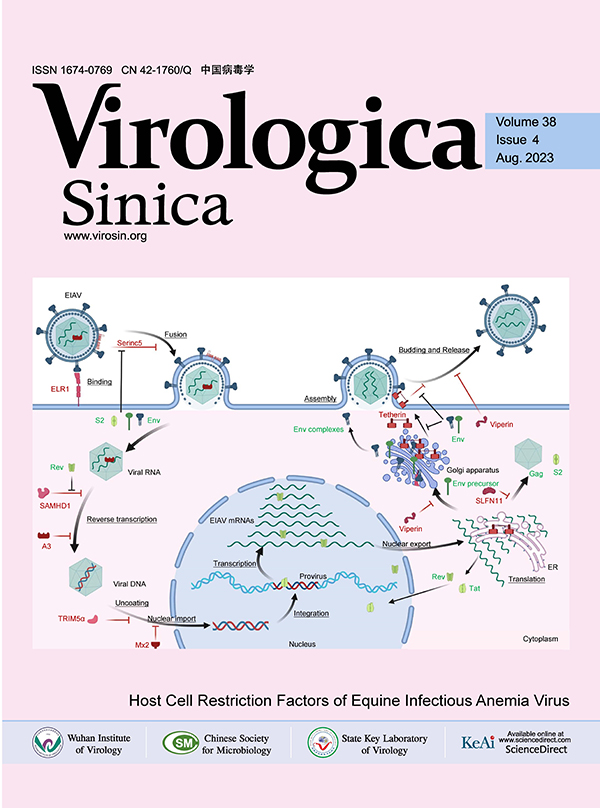-
Amaya M, Keck F, Lindquist M, Voss K, Scavone L, Kehn-Hall K, Roberts B, Bailey C, Schmaljohn C, Narayanan A. 2015. The ubiquitin proteasome system plays a role in venezuelan equine encephalitis virus infection. PLoS One, 10:e0124792.
-
Ballinger CA, Connell P, Wu Y, Hu Z, Thompson LJ, Yin LY, Patterson C. 1999. Identification of chip, a novel tetratricopeptide repeat-containing protein that interacts with heat shock proteins and negatively regulates chaperone functions. Mol Cell Biol, 19:4535-4545.
-
Benditt DG, Markowitz HT. 1986. Permanent cardiac pacing in the era of peer review. The acceptable indications and the necessary documentation. Postgrad Med, 80:123-136.
-
Bourai M, Lucas-Hourani M, Gad HH, Drosten C, Jacob Y, Tafforeau L, Cassonnet P, Jones LM, Judith D, Couderc T, Lecuit M, Andre P, Kummerer BM, Lotteau V, Despres P, Tangy F, Vidalain PO. 2012. Mapping of chikungunya virus interactions with host proteins identified nsp2 as a highly connected viral component. J Virol, 86:3121-3134.
-
Brown RS, Wan JJ, Kielian M. 2018. The alphavirus exit pathway:What we know and what we wish we knew. Viruses, 10:89.
-
Burt FJ, Rolph MS, Rulli NE, Mahalingam S, Heise MT. 2012. Chikungunya:A re-emerging virus. Lancet, 379:662-671.
-
Carissimo G, Chan YH, Utt A, Chua TK, Bakar FA, Merits A, Ng LFP. 2019. Vcp/p97 is a proviral host factor for replication of chikungunya virus and other alphaviruses. Front Microbiol, 10:2236.
-
Chen B, Retzlaff M, Roos T, Frydman J. 2011. Cellular strategies of protein quality control. Cold Spring Harb Perspect Biol, 3:a004374.
-
Ciechanover A, Kwon YT. 2017. Protein quality control by molecular chaperones in neurodegeneration. Front Neurosci, 11:185.
-
Contu L, Balistreri G, Domanski M, Uldry AC, Mühlemann O. 2021. Characterisation of the semliki forest virus-host cell interactome reveals the viral capsid protein as an inhibitor of nonsense-mediated mrna decay. PLoS Pathog, 17:e1009603.
-
Das P, Dudley JP. 2021. How viruses use the vcp/p97 atpase molecular machine. Viruses, 13:1881.
-
de Groot RJ, Rümenapf T, Kuhn RJ, Strauss EG, Strauss JH. 1991. Sindbis virus rna polymerase is degraded by the n-end rule pathway. Proc Natl Acad Sci U S A, 88:8967-8971.
-
Dominguez F, Shiliaev N, Lukash T, Agback P, Palchevska O, Gould JR, Meshram CD, Prevelige PE, Green TJ, Agback T, Frolova EI, Frolov I. 2021. Nap1l1 and nap1l4 binding to hypervariable domain of chikungunya virus nsp3 protein is bivalent and requires phosphorylation. J Virol, 95:e0083621.
-
Enserink M. 2007. Infectious diseases. Chikungunya:No longer a third world disease. Science, 318:1860-1861.
-
Fros JJ, Geertsema C, Zouache K, Baggen J, Domeradzka N, van Leeuwen DM, Flipse J, Vlak JM, Failloux AB, Pijlman GP. 2015. Mosquito rasputin interacts with chikungunya virus nsp3 and determines the infection rate in aedes albopictus. Parasit Vectors, 8:464.
-
Gamage DG, Hendrickson TL. 2013. Gpi transamidase and gpi anchored proteins:Oncogenes and biomarkers for cancer. Crit Rev Biochem Mol Biol, 48:446-464.
-
Glickman MH, Ciechanover A. 2002. The ubiquitin-proteasome proteolytic pathway:Destruction for the sake of construction. Physiol Rev, 82:373-428.
-
Götte B, Panas MD, Hellström K, Liu L, Samreen B, Larsson O, Ahola T, McInerney GM. 2019. Separate domains of g3bp promote efficient clustering of alphavirus replication complexes and recruitment of the translation initiation machinery. PLoS Pathog, 15:e1007842.
-
Hafirassou ML, Meertens L, Umaña-Diaz C, Labeau A, Dejarnac O, Bonnet-Madin L, Kümmerer BM, Delaugerre C, Roingeard P, Vidalain PO, Amara A. 2017. A global interactome map of the dengue virus ns1 identifies virus restriction and dependency host factors. Cell Rep, 21:3900-3913.
-
Holmes AC, Basore K, Fremont DH, Diamond MS. 2020. A molecular understanding of alphavirus entry. PLoS Pathog, 16:e1008876.
-
Inoue Y, Aizaki H, Hara H, Matsuda M, Ando T, Shimoji T, Murakami K, Masaki T, Shoji I, Homma S, Matsuura Y, Miyamura T, Wakita T, Suzuki T. 2011. Chaperonin tric/cct participates in replication of hepatitis c virus genome via interaction with the viral ns5b protein. Virology, 410:38-47.
-
Jiang J, Ballinger CA, Wu Y, Dai Q, Cyr DM, Höhfeld J, Patterson C. 2001. Chip is a u-box-dependent e3 ubiquitin ligase:Identification of hsc70 as a target for ubiquitylation. J Biol Chem, 276:42938-42944.
-
Johansson MA. 2015. Chikungunya on the move. Trends Parasitol, 31:43-45.
-
Kaur P, Lello LS, Utt A, Dutta SK, Merits A, Chu JJH. 2020. Bortezomib inhibits chikungunya virus replication by interfering with viral protein synthesis. PLoS Negl Trop Dis, 14:e0008336.
-
Kielian M. 2014. Mechanisms of virus membrane fusion proteins. Annu Rev Virol, 1:171-189.
-
Kielian M, Chanel-Vos C, Liao M. 2010. Alphavirus entry and membrane fusion. Viruses, 2:796-825.
-
Kielian M, Jungerwirth S, Sayad KU, DeCandido S. 1990. Biosynthesis, maturation, and acid activation of the semliki forest virus fusion protein. J Virol, 64:4614-4624.
-
Knowlton JJ, Fernández de Castro I, Ashbrook AW, Gestaut DR, Zamora PF, Bauer JA, Forrest JC, Frydman J, Risco C, Dermody TS. 2018. The tric chaperonin controls reovirus replication through outer-capsid folding. Nat Microbiol, 3:481-493.
-
Matkovic R, Bernard E, Fontanel S, Eldin P, Chazal N, Hassan Hersi D, Merits A, Péloponèse JM, Jr., Briant L. 2019. The host dhx9 dexh-box helicase is recruited to chikungunya virus replication complexes for optimal genomic rna translation. J Virol, 93:e01764-18.
-
Meshram CD, Agback P, Shiliaev N, Urakova N, Mobley JA, Agback T, Frolova EI, Frolov I. 2018. Multiple host factors interact with the hypervariable domain of chikungunya virus nsp3 and determine viral replication in cell-specific mode. J Virol, 92:e00838-18.
-
Morrison TE. 2014. Reemergence of chikungunya virus. J Virol, 88:11644-11647.
-
Murata S, Minami Y, Minami M, Chiba T, Tanaka K. 2001. Chip is a chaperone-dependent e3 ligase that ubiquitylates unfolded protein. EMBO Rep, 2:1133-1138.
-
Panda D, Rose PP, Hanna SL, Gold B, Hopkins KC, Lyde RB, Marks MS, Cherry S. 2013. Genome-wide rnai screen identifies sec61a and vcp as conserved regulators of sindbis virus entry. Cell Rep, 5:1737-1748.
-
Powers AM, Brault AC, Shirako Y, Strauss EG, Kang W, Strauss JH, Weaver SC. 2001. Evolutionary relationships and systematics of the alphaviruses. J Virol, 75:10118-10131.
-
Ramanathan HN, Zhang S, Douam F, Mar KB, Chang J, Yang PL, Schoggins JW, Ploss A, Lindenbach BD. 2020. A sensitive yellow fever virus entry reporter identifies valosin-containing protein (vcp/p97) as an essential host factor for flavivirus uncoating. mBio, 11:e00467-20.
-
Remenyi R, Gao Y, Hughes RE, Curd A, Zothner C, Peckham M, Merits A, Harris M. 2018. Persistent replication of a chikungunya virus replicon in human cells is associated with presence of stable cytoplasmic granules containing nonstructural protein 3. J Virol, 92:e00477-18.
-
Rinaldi L, Delle Donne R, Catalanotti B, Torres-Quesada O, Enzler F, Moraca F, Nisticò R, Chiuso F, Piccinin S, Bachmann V, Lindner HH, Garbi C, Scorziello A, Russo NA, Synofzik M, Stelzl U, Annunziato L, Stefan E, Feliciello A. 2019. Feedback inhibition of camp effector signaling by a chaperone-assisted ubiquitin system. Nat Commun, 10:2572.
-
Scholte FE, Tas A, Albulescu IC, Žusinaite E, Merits A, Snijder EJ, van Hemert MJ. 2015. Stress granule components g3bp1 and g3bp2 play a proviral role early in chikungunya virus replication. J Virol, 89:4457-4469.
-
Schwartz O, Albert ML. 2010. Biology and pathogenesis of chikungunya virus. Nat Rev Microbiol, 8:491-500.
-
Shen JY, Li M, Xie L, Mao JR, Zhou HN, Wang PG, Jiang JY, An J. 2021. Perinatal vertical transmission of chikungunya virus in ruili, a town on the border between china and myanmar. Virol Sin, 36:145-148.
-
van den Boom J, Meyer H. 2018. Vcp/p97-mediated unfolding as a principle in protein homeostasis and signaling. Mol Cell, 69:182-194.
-
Yin H, Yin P, Zhao H, Zhang N, Jian X, Song S, Gao S, Zhang L. 2019. Intraviral interactome of chikungunya virus reveals the homo-oligomerization and palmitoylation of structural protein tf. Biochem Biophys Res Commun, 513:919-924.
-
Zhang M, Windheim M, Roe SM, Peggie M, Cohen P, Prodromou C, Pearl LH. 2005. Chaperoned ubiquitylation——crystal structures of the chip u box e3 ubiquitin ligase and a chip-ubc13-uev1a complex. Mol Cell, 20:525-538.
-
Zhang S, Hu ZW, Mao CY, Shi CH, Xu YM. 2020. Chip as a therapeutic target for neurological diseases. Cell Death Dis, 11:727.
-
Zhang Y, Ozono S, Tada T, Tobiume M, Kameoka M, Kishigami S, Fujita H, Tokunaga K. 2022. March8 targets cytoplasmic lysine residues of various viral envelope glycoproteins. Microbiol Spectr, 10:e0061821.
-
Zheng Y, Kielian M. 2013. Imaging of the alphavirus capsid protein during virus replication. J Virol, 87:9579-9589.
















 DownLoad:
DownLoad: